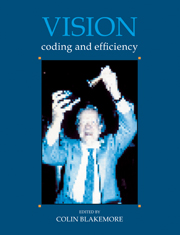Book contents
- Frontmatter
- Contents
- List of Contributors
- Preface
- Reply
- Acknowledgements
- Concepts of coding and efficiency
- Efficiency of the visual pathway
- Colour
- Brightness, adaptation and contrast
- 15 The role of photoreceptors in light-adaptation and dark-adaptation of the visual system
- 16 Why do we see better in bright light?
- 17 Mechanisms for coding luminance patterns: are they really linear?
- 18 Feature detection in biological and artificial visual systems
- Development of vision
- Depth and texture
- Motion
- From image to object
- Index
18 - Feature detection in biological and artificial visual systems
Published online by Cambridge University Press: 05 May 2010
- Frontmatter
- Contents
- List of Contributors
- Preface
- Reply
- Acknowledgements
- Concepts of coding and efficiency
- Efficiency of the visual pathway
- Colour
- Brightness, adaptation and contrast
- 15 The role of photoreceptors in light-adaptation and dark-adaptation of the visual system
- 16 Why do we see better in bright light?
- 17 Mechanisms for coding luminance patterns: are they really linear?
- 18 Feature detection in biological and artificial visual systems
- Development of vision
- Depth and texture
- Motion
- From image to object
- Index
Summary
To function efficiently within reasonable information limits, any visual system, biological or artificial, must simplify the image and record it in some economical form (e.g. Barlow, 1957). Image features, such as lines and edges, are rich sources of information. In this chapter we review a simple, efficient and biologically plausible model of how the human visual system may detect, locate and identify edges and lines in any arbitrary image. The model predicts successfully the appearance of many stimuli (including visual illusions), makes accurate quantitative predictions about thresholds and apparent position, and has been applied successfully to artificial visual systems.
Mach bands
Our research started by considering the conspicuous but paradoxical features, the dark and light lines, that appear on waveforms where luminance ramps meet a plateau, or a ramp of different slope. They are usually referred to as ‘Mach bands’, after the German physicist Ernst Mach, who first observed and studied them more than 100 years ago (Mach, 1865).
Figure 18.1 A shows a clear example of Mach bands, on a trapezoidal waveform. The brightness of the pattern does not follow the luminance distribution, but produces sharp black and white bands, separated by a relatively homogeneous region. The stripes are even more apparent in two dimensions. Figure 18. IB is the product of a vertical and horizontal triangle-wave (from Morrone, Ross, Burr & Owens, 1986). Again brightness does not follow luminance, but clear black and white stars appear at the apexes of the waveform.
- Type
- Chapter
- Information
- VisionCoding and Efficiency, pp. 185 - 194Publisher: Cambridge University PressPrint publication year: 1991
- 1
- Cited by



